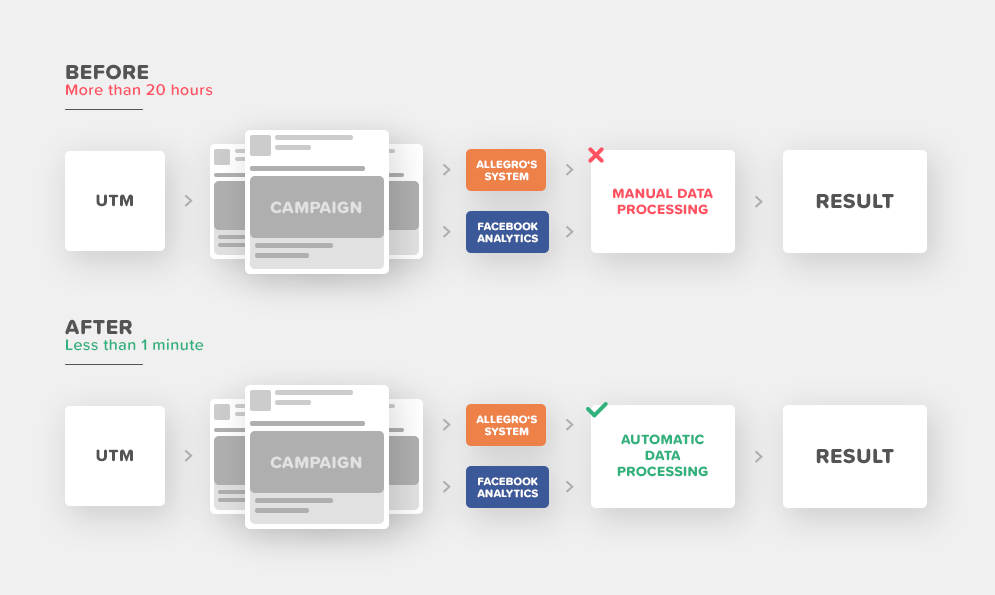Challenge
Last time, my colleague Erik Werner, discussed the blind spots that often occur in online marketing or more specifically how Google and Facebook sometimes provide different attribution. This resulted in Google sometimes misattributing about 21% of Facebook clicks. Each system will provide useful pieces of information but when they do not speak the same language, then key pieces of data could be lost. In the case of attribution between Google and Facebook, sometimes it is hard to know exactly who is to credit for a sale that came as a result of one of the online campaigns. The real pain, of course, is not even knowing what your true ROI is. Without all of the right and relevant pieces of data, you’d be flying partially blind. Not a great way to run campaigns.
So, what happens when you have yet another system to coordinate with? This is the issue that Allegro, one of Poland’s largest retail online shops, had to solve. They have their own system that was developed specifically for their needs. This meant that multiple systems had to be aligned in order to get a holistic view of their marketing efforts. It took literal hours to properly match 1000s of unique data points they had in their system with the data points in ours and on Facebook. The result was that time was lost to simple machine tasks that could be completed by monkeys instead of analyzing and reworking campaigns to maximize ROI.
The old process:
- Send a weekly excel sheet with campaign details.
- Manually match 1000s of campaigns, ad sets and ads to the corresponding spend.
- Lay down in the fetal position.
- Cry.
- Repeat.
Challenge 1:
Their system was set up to calculate data sets such as:
- Number of transactions
- Gross revenue
- Net revenue
Facebook has completely different parameters with which to analyze campaign performance. The result is a limited and delayed understanding of campaign performance.
Challenge 2:
Their system lacks information about ads that brought a visitor to the website. To solve this, marketers often use UTM tags like “campaign” and they keep the relations in their heads for further analysis. However, this approach is impossible for 1000s of campaigns.
 Allegro.pl
Allegro.pl
Solution
What we both needed was a tailored solution so that ALL three systems would provide useful information for quick feedback and analysis. So, our team of solutions engineers came up with the solution:
- We would supply our unique ROI Hunter ID in the UTMs which were made for each ad. The ID could look something like this: utm_content=at1!12526154.
- Allegro then exported their real results from their own internal system. As a result, they would be able to tell that for each unique ROI Hunter ID (utm_content=at1!12526154) there were for example 13 transactions and an X amount of gross and net revenue. This would then be uploaded automatically to our FTP server.
- Our Solution Engineers then prepared a back-end algorithm that matched our id with Allegro’s actual spend on the campaign, ad set and ad levels.
- The data is updated hourly so that our Client Partners can see near real-time results of the campaign for instant adjustments and optimization.
 Allegro.pl Our solution
Allegro.pl Our solution
Result
After the integration, these are the results, we came up with.
- Within three weeks we were able to fully match all data sets for an automated workflow.
- Days of work were whittled down to minutes so that campaigns could be optimized at every level.
- We had free time to try other tests to further drill down into data that we received from Facebook pixels like clicks, impressions and an in-depth analysis that has actionable results for sales.
- Increase ROI X 7.4 compared to the two previous months without the full integration.
The lesson to learn from this is that, when you have the complete picture and are able to react quickly, then your ROI can be improved drastically.
Tailored Solutions:
This is all nice and great but what does that mean for you? No two companies are alike and finding the right solution for your specific need can be agonizing for any company. You might have to sacrifice pieces of actionable data for a service or miss out on services that are right for your business because the perceived drawbacks outweigh the loss.
If you want to succeed, you will need tailored solutions from the right platform. So, the question to ask is: Are your systems and marketing platforms interacting with each other in such a way that you have the best analysis to base your strategies on? If not, it might be time to make sure that they do.
 Allegro.pl
Allegro.pl